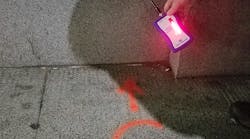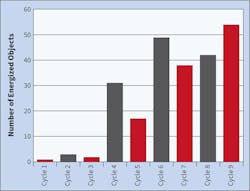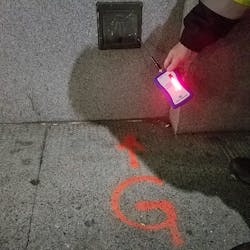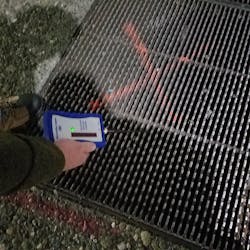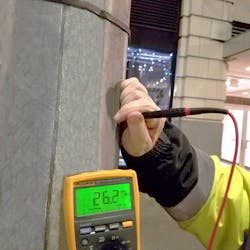Contact Voltage Testing: Tricks of the Trade
Detection of uncontrolled electricity along city streets and sidewalks is a concern for many municipalities and utilities. The preferred method of identifying these locations is to seek out these voltages preemptively rather than waiting for a citizen to report a shock to themselves or, more typically, their dog. Once a suspected energized object is identified, accurate measurements must be taken to confirm or deny the presence of a voltage potential on the object under test. The practice of using water system piping or components as a qualified reference ground is common, but the case study presented here shows the pitfalls of using those items.
This article examines an incident in which 237 contact voltages were reported in a relatively very small area over a period of nine testing cycles. It was the proper application of IEEE 1695-2016, Guide to Understanding, Diagnosing and Mitigating Stray and Contact Voltage, that identified the “qualified” reference ground being used to take the voltage readings was itself energized, contributing to the large number of reported contact voltages.
Contact voltage detection/reporting
Unwanted voltages on objects such as conductive streetlights, traffic signal equipment, and sidewalk junction boxes can be identified several different ways. If you work for a municipality or utility, the least desirable method of identification is to have your boss call you on a Sunday evening and ask you why some citizen is on the local news talking about how their dog was shocked or killed by a street light your department maintains.
The more practical method of detecting these voltages is to have a preemptive testing program as detailed in IEEE 1695. This could be a foot patrol type of survey for a smaller town or a mobile survey for larger geographical areas and bigger cities. Foot patrol surveys involve using handheld testers and walking from object to object; mobile surveys incorporate equipment mounted to a vehicle (typically a truck), which is driven down the street. Each type of survey has its advantages and disadvantages, but both are initial mass screening techniques — that is, each method is used to quickly determine if an object requires additional testing or a more detailed examination. Each survey method, upon a positive indication from their respective technologies, requires additional investigation and an understanding of the electrical system to further evaluate findings.
Confirmation testing
Since the two primary technologies used to screen for contact voltages are spectrum analyzers or electric field detectors, any signal strength reading above a certain predetermined level calls for further investigation by the testing technician. This is done using a voltmeter and making a measurement between two different points. One of those points must be a qualified reference ground (i.e., some object in direct earth contact far enough away from the object under test so it does not have a voltage on it) and the second point being the object under test/investigation.
Qualified reference grounds can include, but are not limited to, portable ground rods, bolts, or other metal objects embedded in sidewalk concrete, water pipes, and fire hydrants. One test lead of the voltmeter is connected to the qualified reference ground, and the other test lead is touched or connected to the object under test/investigation. The test technician then notes a reading on the voltmeter. Any confirmed voltage readings are then graded and processed in accordance with local policies.
Water pipes as a qualified reference
The biggest problem with using water pipes and fire hydrants as a qualified reference ground is that you generally cannot see what is going on underground or inside the wall of a building. This means you don’t know if the buried/hidden section of pipe you are using is metal, plastic, or has some other issue.
One water industry group estimates that one-third of all municipal water main and distribution system piping is now PVC or PEI. Many newer buildings use PVC or PEX for water lines. The working ends of these pipes (fire hydrants, faucets, or bibs) generally are made of metal to provide some sort of protection to the water line itself. For this reason alone, water piping should not be considered as a reliable qualified reference ground as it may not have a direct and low-impedance connection to earth.
Metal piping in buildings has an additional problem if used as a qualified reference ground. By code, it is required to be bonded to the electrical system even if it is not used as a grounding electrode. Because of wiring errors and/or lack of electrical system maintenance, it is not unusual to find small voltages on a building’s metal water pipes… the very problem found in this case study.
A growing problem
Mobile test equipment detected a potential problem in front of a building several years ago. The first three testing cycles were typical findings expected from a normal mobile voltage survey. However, something drastically changed during testing Cycle 4 as seen in the Figure below.
The dramatic increase in Cycle 4 voltage findings should have alerted someone to the fact that:
1) A catastrophic underground electrical failure was looming at this location, or
2) The voltage measurement (confirmation testing) process had somehow been compromised.
In this instance, it was the latter. Cycle 4 was the first time mobile survey technicians used a water bib on the outside of an adjacent building as a qualified reference ground. The same was true for the subsequent five testing cycles (i.e., the building’s water system was used as the qualified reference ground point). It was not until after Cycle 9, and a different set of eyes looking at the situation, that the voltage measurement error was identified.
IEEE 1695 features a well-developed flow chart on how to detect and quantify contact voltages. One of those steps includes a process to validate that the qualified reference ground itself does not have a preexisting voltage potential on it.
Photo 1, below, shows one of the methods the standard recommends to validate a qualified reference ground. In this instance, a handheld voltage detector is being used. The orange “G” on the sidewalk is the original contractor’s mark showing this was the water bib used as their qualified reference ground. The red LEDs on the handheld voltage detector indicate that the bib has voltage potential on it. The bib is located behind the metal security cover.
Another step overlooked by the contractor in this case study was failing to use a contact voltage detector to further screen objects for possible voltages as demonstrated in Photo 2, below. This metal grate is located about 15 ft away from the water bib in Photo 1. The painted orange “X” means it was reported as having a contact voltage on it, but the voltage detector clearly shows no electric field being emitted. During a mobile survey, the screening shown in Photo 2 is the second step in the IEEE flow chart. In a foot patrol survey, also called a “manual survey,” Photo 2 is the first step in the flow chart. When the voltage is measured between the grate and the energized water bib, there is, in fact, a measurable voltage (1.4V with 6.5% total harmonic distortion [THD]). When a measurement is taken between this grate and a true qualified reference ground, there is no potential validating what the contact voltage detector is showing.
Photo 3 shows a light pole reported as having 2.1V (6.6% THD) on it, but the contact voltage indicator showed no electric field and the voltmeter confirms millivolts on the pole. In this case, as in Photo 2, a proper qualified reference was used rather than the energized water bib.
Lessons learned
Because the building water piping itself was energized and was the true source of voltage, any conductive object the testing technician touched with the second voltmeter test lead would erroneously indicate that the object had a contact voltage on it. This explains the drastic increase in findings starting in test Cycle 4 — a change in the qualified reference ground over the previous three testing cycles. Thankfully, the utility decided to monitor this situation over time rather than immediately start a major upgrade to the underground electrical distribution system, which would have cost tens of thousands of dollars. This would have left them perplexed as to why the “fix” didn’t work during the next test cycle as the testing technician again used the same energized water bib as a qualified reference ground.
Voigtsberger is president of Florida-based Utility Testing and Geographic Information Systems LLC. He has written extensively about electrical safety and contact voltage testing over the last 20 years. He can be reached at [email protected].
Sidebar: Real-World Tip
Any fault voltage going to earth will produce a voltage gradient. If you have a true qualified reference point at zero potential, then your voltage readings will increase (or decrease) as you move to or from the energized object as you make your voltage readings. Using this method, you can frequently pinpoint the actual location of the fault. If your voltage readings are consistent over a large area, then the likely culprit is a voltage on the qualified reference ground.
